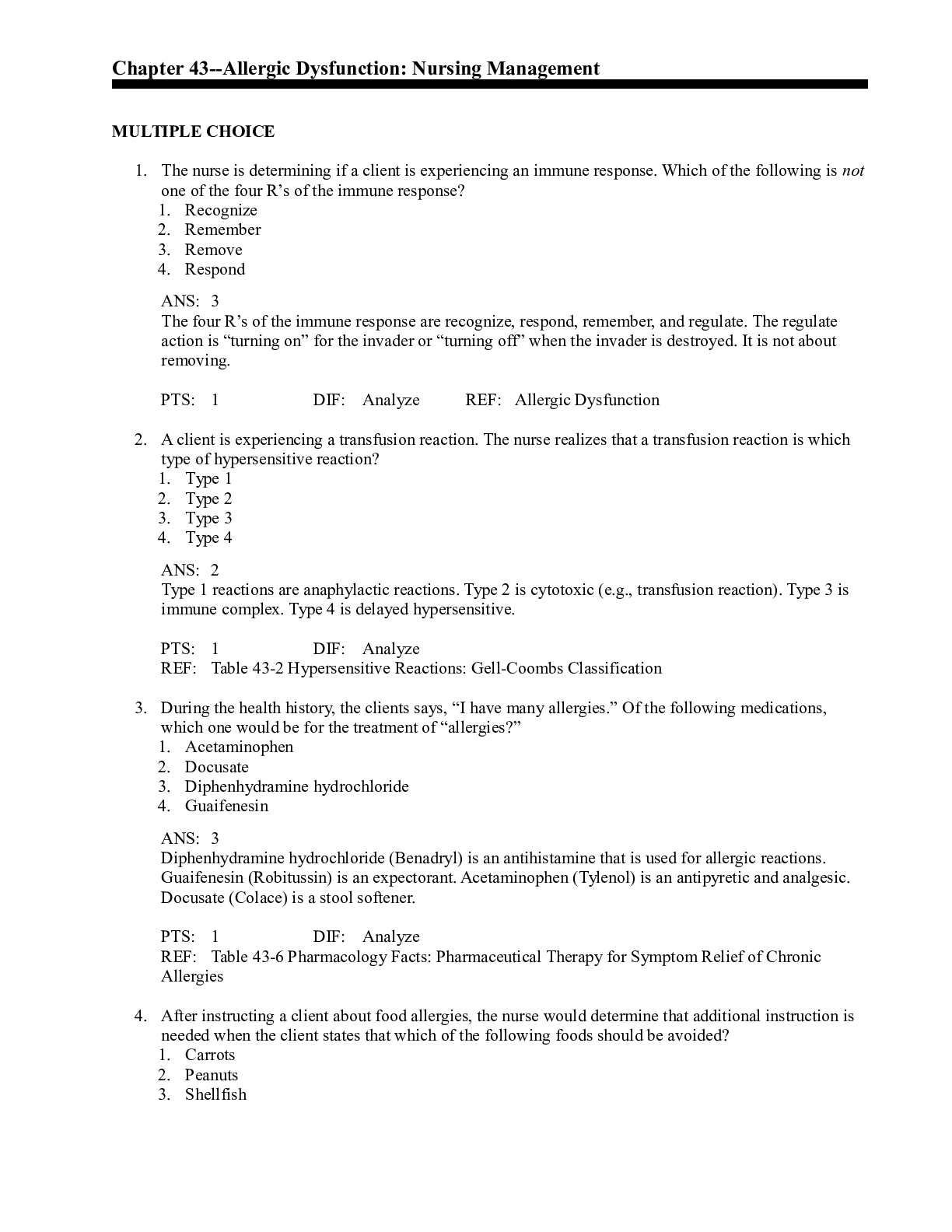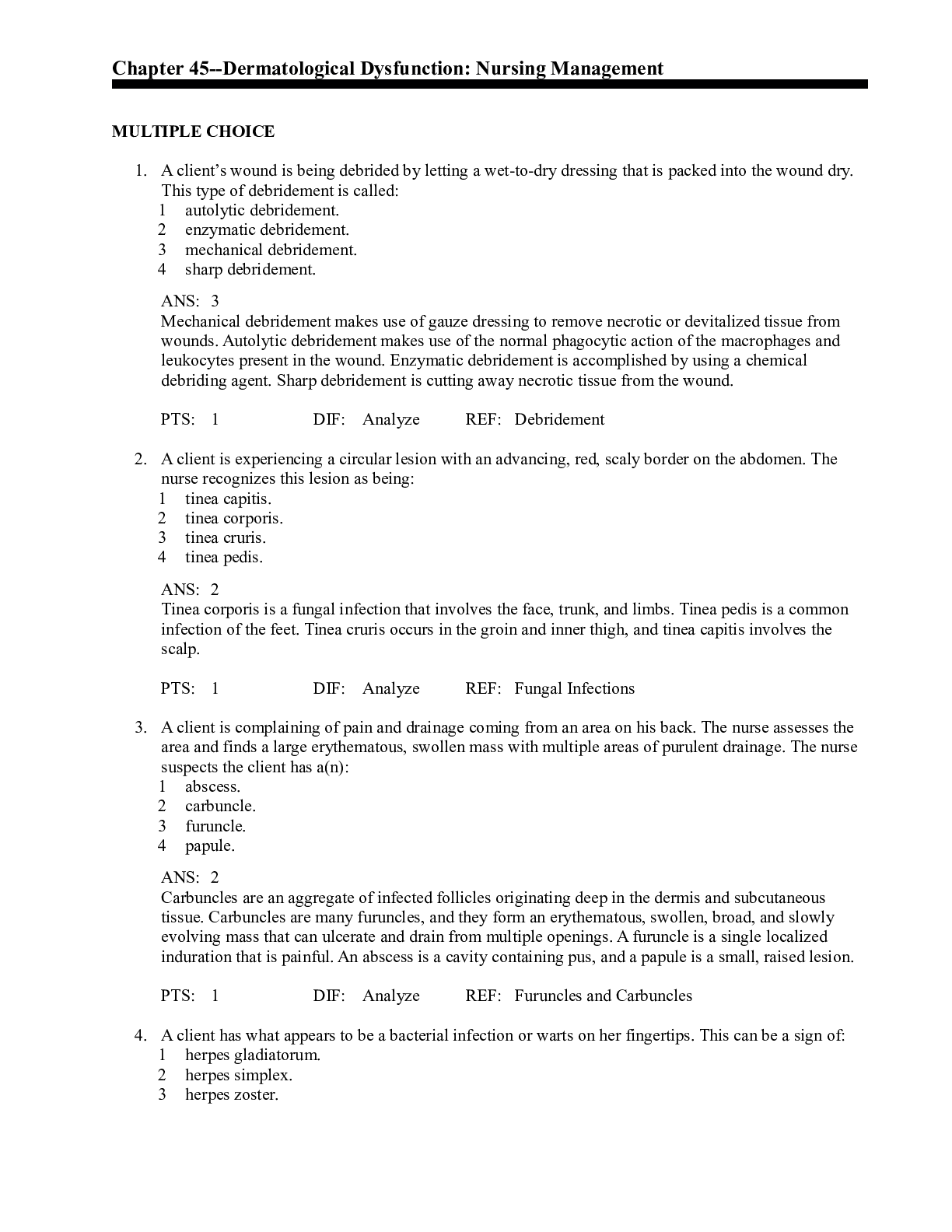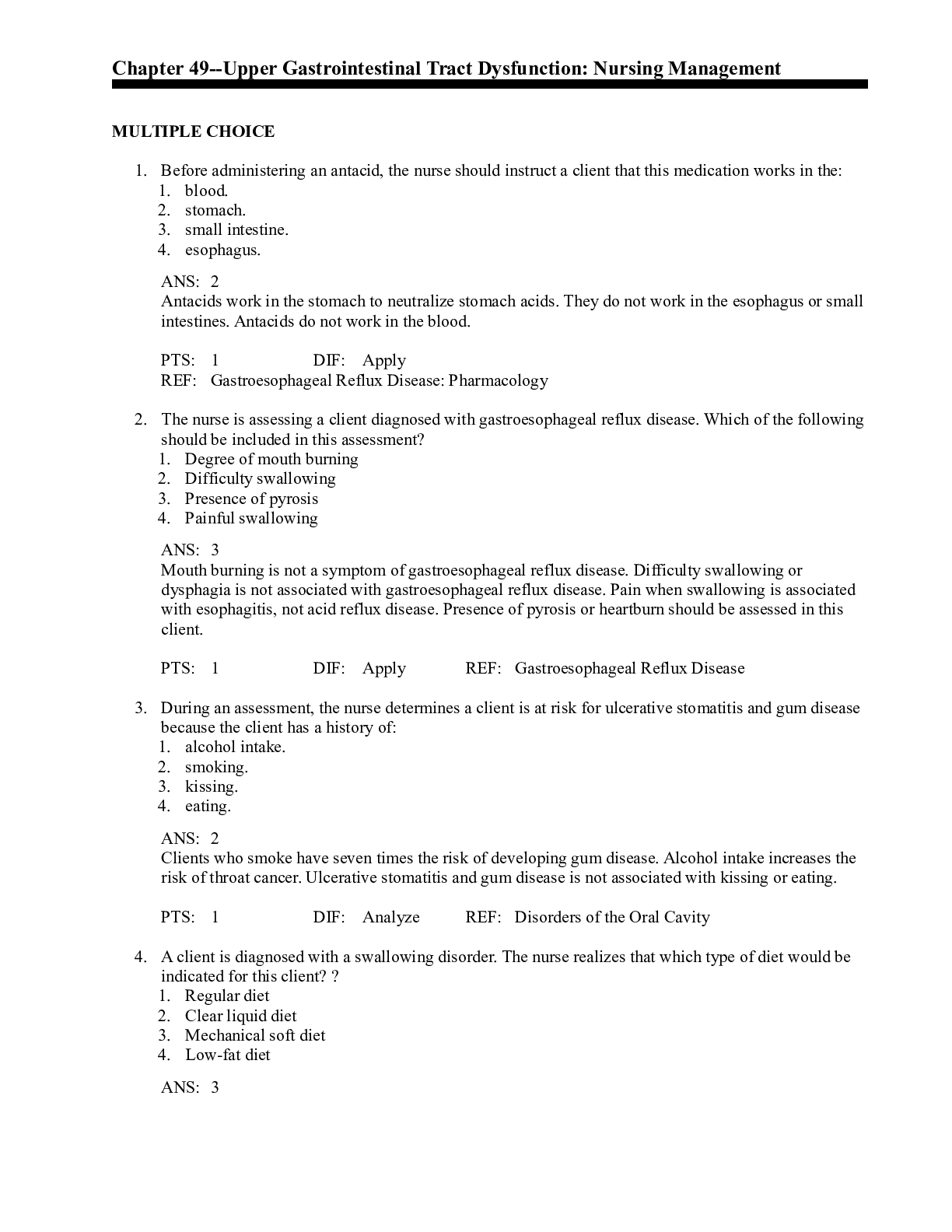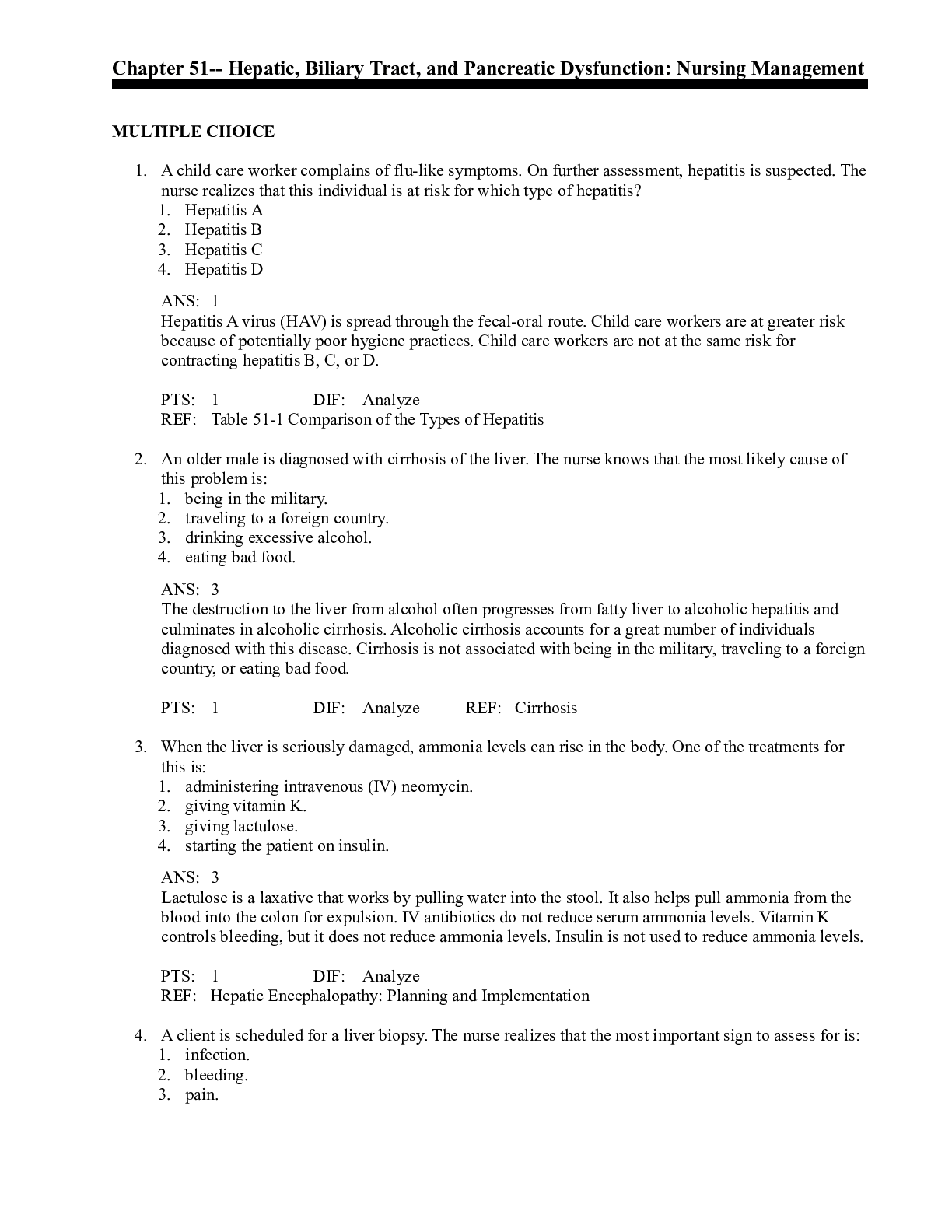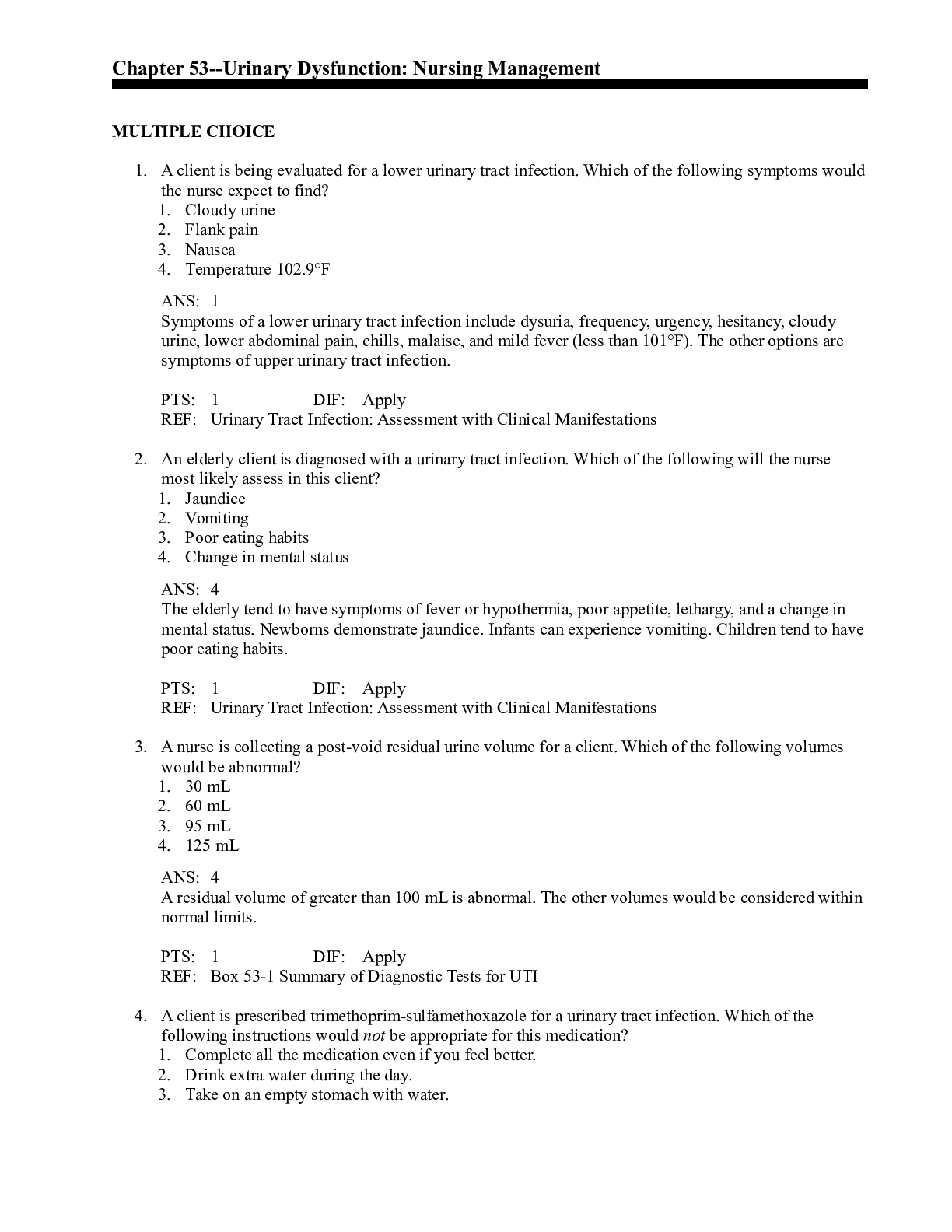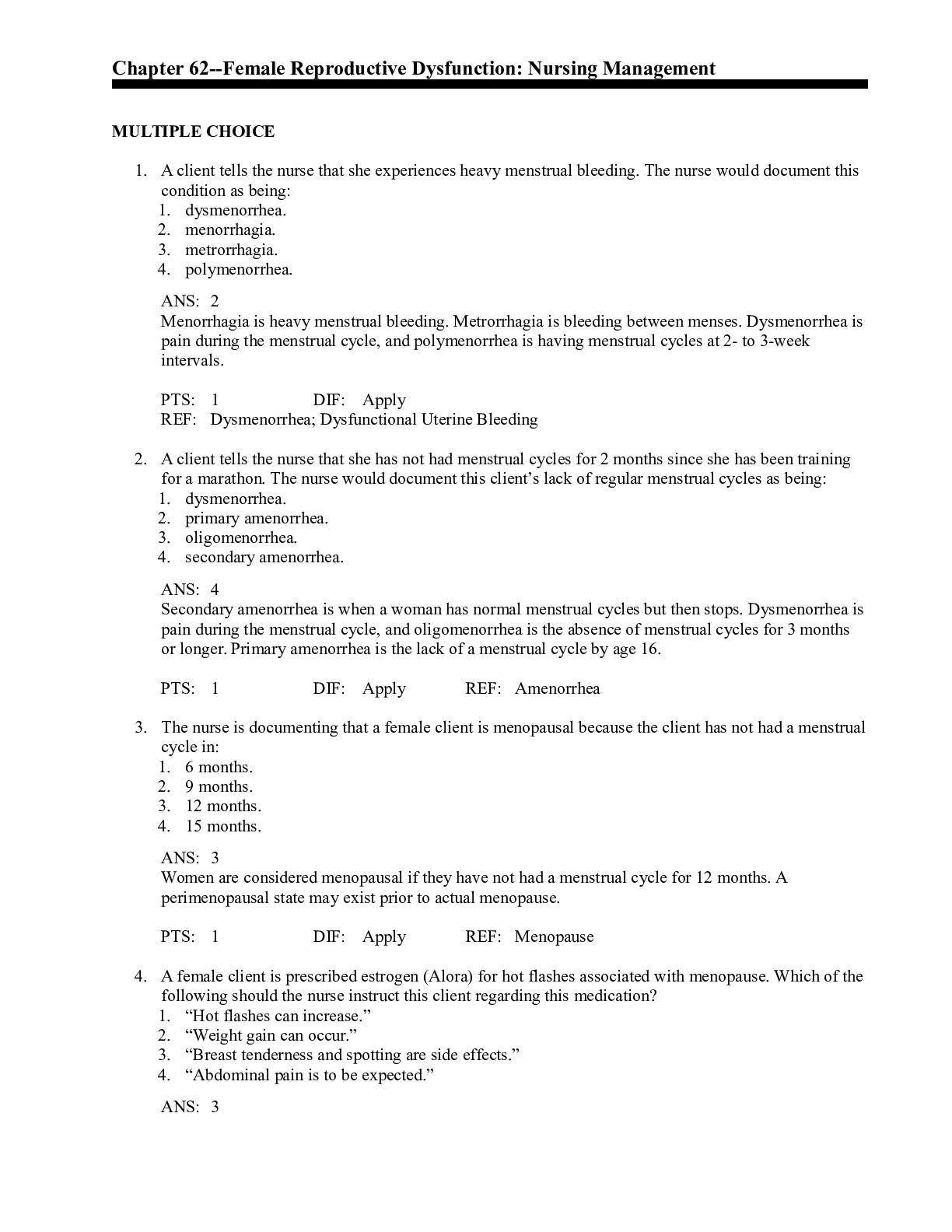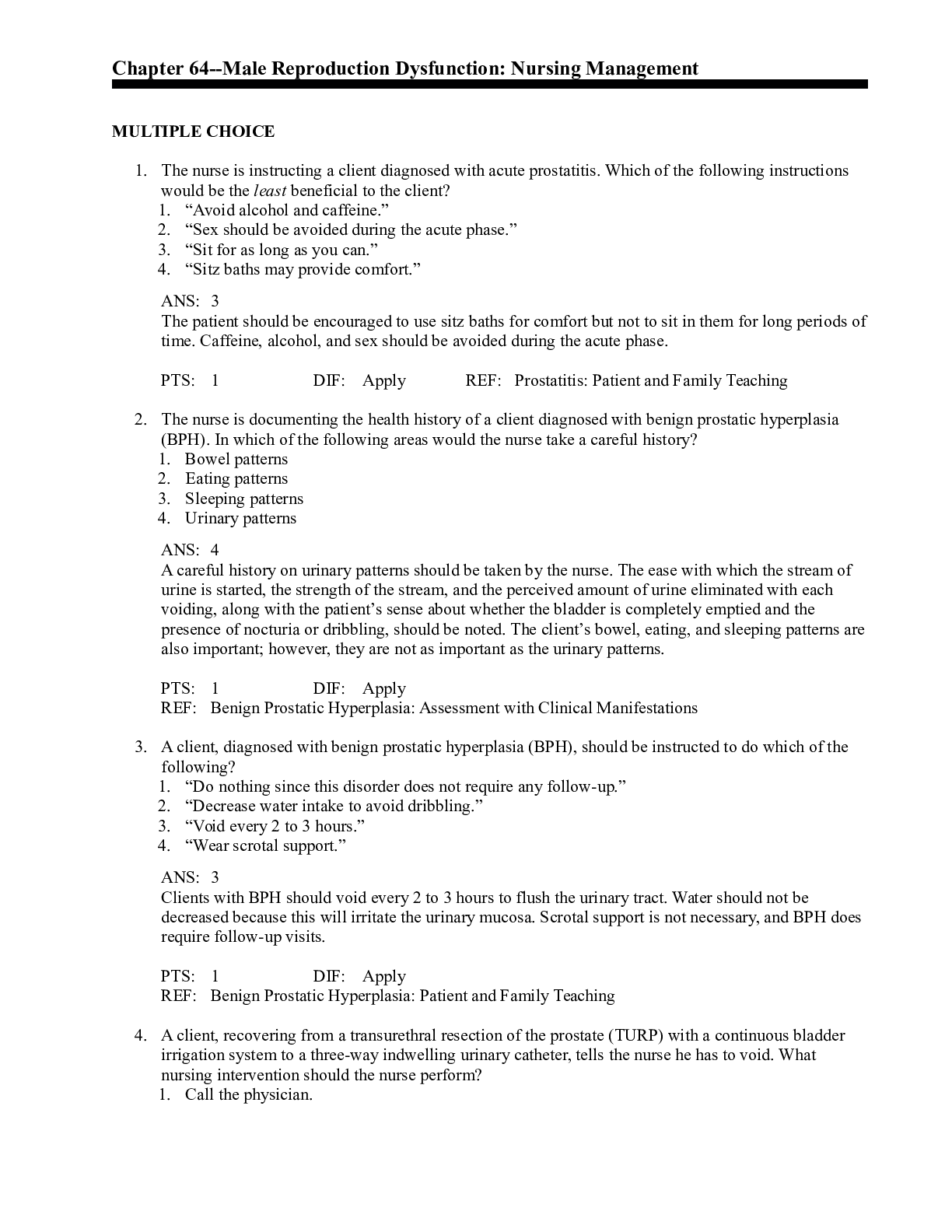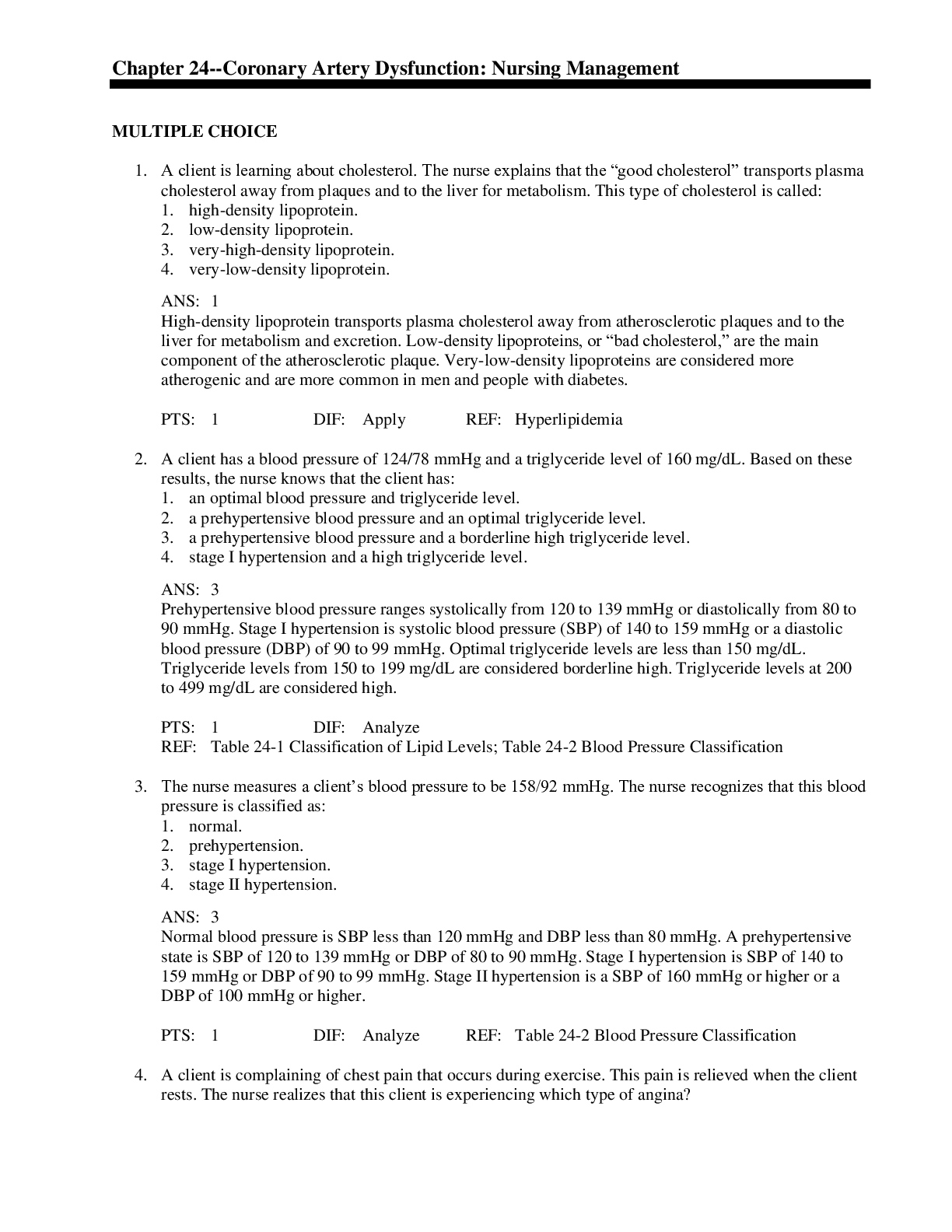*NURSING > QUESTIONS & ANSWERS > Chapter 56--Endocrine Dysfunction: Nursing Management (All)
Chapter 56--Endocrine Dysfunction: Nursing Management
Document Content and Description Below
Chapter 56--Endocrine Dysfunction: Nursing Management MULTIPLE CHOICE 1. A male client is diagnosed with hyperprolactinemia. The nurse realizes that which of the following clinical manifestations o... ccurs less frequently in men? 1. A decrease in testosterone 2. Erectile dysfunction 3. Gynecomastia 4. Infertility PTS: 1 DIF: Analyze REF: Hyperprolactinemia: Assessment with Clinical Manifestations 2. A female client is admitted with hyperprolactinemia. Which of the following would not be a clinical manifestation of the disorder in this client? 1. Excessive estrogen 2. Hirsutism 3. Osteoporosis 4. Weight gain PTS: 1 DIF: Analyze REF: Hyperprolactinemia: Assessment with Clinical Manifestations 3. A client has been instructed regarding a prolactin level to be drawn the next day. Which of the following statements indicate that the client will need further instruction? 1. “I will be on time, in the afternoon.” 2. “I will be relaxed.” 3. “I will make sure not to take my antihistamine.” 4. “I will practice another method of birth control rather than the pill.” PTS: 1 DIF: Analyze REF: Box 56-1 Prolactin Levels 4. An adult client is complaining of vision changes and difficulty speaking because the tongue is larger. The client also states that his shoes no longer fit. Based on these symptoms, the client is most likely to be diagnosed with: 1. acromegaly. 2. cretinism. 3. gigantism. 4. Graves’ disease. PTS: 1 DIF: Analyze REF: Acromegaly (Gigantism): Assessment with Clinical Manifestations 5. A client is prescribed medication after recovering from surgery to treat acromegaly. Which of the following medications would the nurse expect to see prescribed? 1. None 2. Cabergoline (Dostinex) 1 mg PO twice a week 3. Cortisone acetate (Cortone) 100 mg PO three times a day 4. Octreotide (Sandostatin) 20 mg IM every 4 weeks PTS: 1 DIF: Analyze REF: Acromegaly (Gigantism): Pharmacology 6. A client, complaining of weight gain, has thin extremities, a “buffalo hump,” and a protruding abdomen. The nurse realizes that this client is most likely to be diagnosed with which disease process? 1. Addison’s disease 2. Cretinism 3. Cushing’s syndrome 4. Obesity PTS: 1 DIF: Analyze REF: Cushing's Disease (Hypercortisolism): Assessment with Clinical Manifestations 7. The nurse is providing instructions to a client receiving treatment for Cushing’s syndrome. Which of the following instructions would not be appropriate for this client? 1. Monitor glucose levels. 2. Implement safety precautions. 3. Wear medical identification. 4. Volunteer at the hospital to prevent depression. PTS: 1 DIF: Apply REF: Cushing's Disease (Hypercortisolism): Planning and Implementation 8. The nurse is assessing a client diagnosed with hyperaldosteronism. Which of the following would take the least priority during this period? 1. Assessment of breath sounds 2. Cardiac monitoring 3. Assistance with activities of daily living (ADLs) 4. Review of electrolyte levels PTS: 1 DIF: Analyze REF: Hypersecretion of the Adrenal Gland (Hyperaldosteronism): Assessment with Clinical Manifestations 9. A client is diagnosed with primary adrenal insufficiency. The nurse realizes that this disorder affects which of the following glands? 1. Adrenal cortex 2. Adrenal medulla 3. Thyroid 4. Pituitary PTS: 1 DIF: Analyze REF: Hyposecretion of the Adrenal Gland: Pathophysiology 10. A client tells the nurse that he is “so thirsty” that he has already consumed four pitchers of water. The client’s urine output is 3500 mL in an 8-hour period. The client is recovering from surgery on the pituitary gland. What endocrine disorder is the client most likely experiencing? 1. Diabetes insipidus 2. Diabetes mellitus 3. Myxedema 4. Syndrome of inappropriate antidiuretic hormone secretion PTS: 1 DIF: Analyze REF: Diabetes Insipidus: Assessment with Clinical Manifestations 11. The nurse is planning care for a client diagnosed with Graves’ disease. Which of the following nursing interventions would be appropriate for this client’s care? 1. Administer a stool softener. 2. Provide extra blankets. 3. Provide frequent meals. 4. Restrict the caloric intake. PTS: 1 DIF: Apply REF: Hypersecretion of the Thyroid Gland: Planning and Implementation 12. A client is hospitalized with an ongoing fever. The nurse learns that the client has had a recent infection. Currently the client is restless, diaphoretic, and agitated with the following vital signs: temperature 106°F, pulse 114, blood pressure 180/80 mmHg. Which of the following disorders is the client most likely experiencing? 1. Addisonian crisis 2. Goiter 3. Myxedema 4. Thyroid crisis PTS: 1 DIF: Analyze REF: Thyroid Crisis (Thyroid Storm) 13. A pregnant client is receiving treatment for hyperthyroidism. Which of the following medications would the nurse expect to see? 1. Levothyroxine 2. Methimazole 3. Propylthiouracil 4. Radioactive iodine PTS: 1 DIF: Analyze REF: Hypersecretion of the Thyroid Gland: Pharmacology 14. A client is diagnosed with chronic lymphocytic thyroiditis. The nurse should instruct the client regarding signs and symptoms of which of the following? 1. Type 2 diabetes mellitus 2. Heart failure 3. Hypothyroidism 4. Renal failure PTS: 1 DIF: Apply REF: Thyroiditis MULTIPLE RESPONSE 1. Which of the following symptoms would suggest to the nurse that a client is experiencing symptoms of pheochromocytoma? (Select all that apply.) 1. Severe headache 2. Decreased urine output 3. Palpitations 4. Diarrhea 5. Profuse sweating 6. Weight gain PTS: 1 DIF: Analyze REF: Pheochromocytoma: Assessment with Clinical Manifestations 2. A client is receiving diagnostic tests to determine the presence of a malignant thyroid lesion. Which of the following are symptoms that are usually associated with a malignant thyroid? (Select all that apply.) 1. Hoarseness 2. Onset of dysphagia 3. Age 20; male gender 4. Thyroid scan revealing a cold nodule 5. Soft nodules 6. Presence of a single firm nodule PTS: 1 DIF: Analyze REF: Table 56-5 Comparison of Benign and Malignant Thyroid Lesions 3. The nurse suspects a client is experiencing the early signs of myxedema coma when which of the following is assessed? (Select all that apply.) 1. Reduced level of consciousness 2. Hypothermia 3. Hypoventilation 4. Hypotension 5. Bradycardia 6. Reduced urine output PTS: 1 DIF: Analyze REF: Myxedema Coma 4. The nurse is planning care for a client diagnosed with hypercalcemia caused by hyperparathyroidism. Which of the following should the nurse add as interventions to this client’s care plan? (Select all that apply.) 1. Administer high volume intravenous fluids as prescribed. 2. Monitor arterial blood gases. 3. Calculate sodium chloride intake to achieve 400 mEq each day. 4. Provide low rates of intravenous fluids. 5. Provide thyroid replacement medication orally. 6. Monitor body temperature. PTS: 1 DIF: Apply REF: Hyperparathyroidism: Planning and Implementation [Show More]
Last updated: 1 year ago
Preview 1 out of 6 pages

Buy this document to get the full access instantly
Instant Download Access after purchase
Add to cartInstant download
We Accept:

Reviews( 0 )
$5.00
Document information
Connected school, study & course
About the document
Uploaded On
Jan 21, 2020
Number of pages
6
Written in
Additional information
This document has been written for:
Uploaded
Jan 21, 2020
Downloads
0
Views
65













